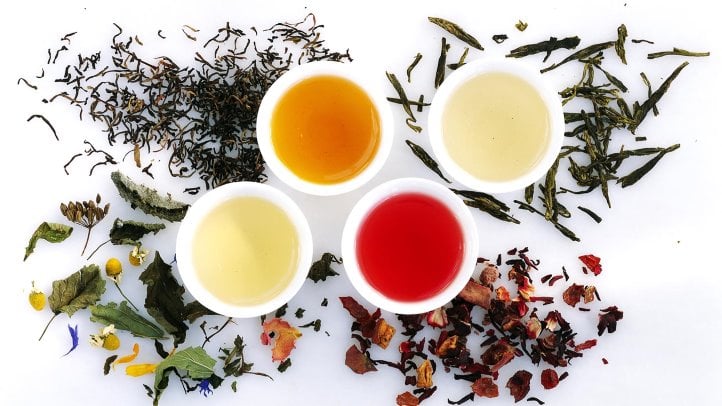I admit that I have a “drinking” problem—I am addicted to green tea! For me, it’s a taste that I’ve grown used to. My dad was a big tea drinker. As far as I could remember, the only “water” form I drank is tea, starting from daddy’s cup, of course.
Green tea is packed with antioxidants, to which most of the green tea health benefits have been attributed, including green tea’s anti-aging effect. Recently, I had an honor of meeting a world leading gut microbiota expert. Over the dinner, we chatted about carbohydrates (i.e., starch)’s effect on gut microbiota. The professor told me that carbohydrates promote good gut microbiota population according to his research. However, the problem is that carbohydrates in our food are highly processed and easily digested by starch hydrolyses (i.e., enzymes) in our mouth and stomach, very small amount of carbohydrates can survive the upper digestive track and reach our guts. As a side effect, because the starch is so easily digested, the blood glucose tends to shoot up quickly during the meal, leading to glycemic shock for diabetics.
The discussion made me think that, if tea could inhibit the activity of starch hydrolyses, starch would be digested more slowly and more will reach gut promoting the healthy microbiota population. With that, I started digging. It turns out that green tea’s inhibition effect on starch digestion is a well-researched area.
As early as in 1998, Forsyth Dental Center researchers compared the inhibition effect of salivary amylase by black and green teas and their effects on the intraoral hydrolysis of starch. It was found that both black and green teas inhibited amylase in human saliva. Since salivary amylase hydrolyzes food starch to low molecular weight fermentable carbohydrates, experiments were carried out to determine whether tea decoctions would interfere with the release of maltose in food particles that became entrapped on the dentition. The results showed that tea consumption is effective in reducing the cariogenic potential of starch-containing foods such as crackers and cakes. Tea may reduce the tendency for these foods to serve as slow-release sources of fermentable carbohydrate.
In 2012, Penn State University researchers published a paper on “Molecular Nutrition & Food Research.” The paper examined the effect of co-administration of green tea polyphenol, (-)-epigallocatechin-3-gallate, on blood glucose levels following oral administration of common corn to fasted CF-1 mice. It was found that green tea polyphenol significantly reduced postprandial blood glucose levels after administration of corn starch. But the same effect was not observed on postprandial blood glucose following administration of maltose or glucose, suggesting that green tea polyphenol may modulate amylase-mediated starch digestion.
An article published in 2012 on J. Agric Food Chem by a group of researchers from Oregon State University evaluated the inhibitory effects of plant-based extracts including green tea, and white tea and their constituent flavan-3-ol monomers (catechins) on α-amylase and α-glucosidase activity, two key glucosidases required for starch digestion in humans. Results showed that tea extracts and catechin 3-gallates were potent inhibitors of α-glucosidase.
A group from Oxford Brookes University published a paper in 2013 on the International Journal of Food Science. In the paper, the authors noted that green tea was the only tea shown to significantly reduce sugar release from white bread.
Therefore, green tea not only retards the wrinkle formation through its antioxidants’ radical scavenging effect but also reduces the starch digestion and prevents spiking of blood glucose level. In addition, green tea allows more starch and carbohydrate nutrients to reach gut therefore promoting health gut microbiota population, which is known to have the effect of reducing systemic inflammation and stress.
If you are still not convinced of the benefits of drinking green tea, green tea is also shown to reduce risk of coronary heart disease,1 stroke incidence,2 chronic inflammation,3 and cancer incidence.4 So, before your next meal, order a green tea and start drinking your way to a perfect skin and a greater health.
Thanks for reading.
Journal References:
1. K. J. Mukamal, K. MacDermott, J. A. Vinson, N. Oyama, W. J. Manning, and M. A. Mittleman, A 6-month randomized pilot study of black tea and cardiovascular risk factors, The American Heart Journal, 154(4), pp. 724.e1–726.e1, 2007.
2. S. O. Keli, M. G. L. Hertog, E. J. M. Feskens, and D. Kromhout, Flavonoids, antioxidant vitamins and risk of stroke: the Zutphen Study, Archives of Internal Medicine, 154, pp. 637–642, 1995.
3. V. Sharma and L. J. M. Rao, A thought on the biological activities of black tea, Critical Reviews in Food Science and Nutrition, 49( 5), pp. 379–404, 2009.
4. T. Kuzuhara, M. Suganuma, and H. Fujiki, Green tea catechin as a chemical chaperone in cancer prevention, Cancer Letters, 261 (1), pp. 12–20, 2008.
About SGC:SGC is an R&D focused developer of nutraceutical and pharmaceutical gummy products. The company specializes in formulating Functional Gummy® products combining the wealth of the in-house knowledge in pharmaceutics, chemistry, western medicine and herbal medicine. The company provides performance gummies® inspired by Traditional Chinese Medicine including MOCCA SHOTS™, ENERGON QUBE™, FUNTIONAL FRUIT®, and SEATTLE BEAUTY®.
To learn more, visit https://seattlegummy.com, contactinfo@seattlegummy.com,call 206-257-0464, or join at https://seattlegummy.com/be-an-informed-member/.
PERFORMANCE GUMMIES | FREE SHIPPING ON ORDERS OVER $50
- Our Story
- Locations
- Blog
- Contact
-
Newsletter
SIGN UP FOR NEWSLETTER
Signup for our newsletter to be notified about product discounts and coupons, performance and nutritional tips and latest research breakthroughs in nutrition and healthy living.
PERFORMANCE GUMMIES | FREE SHIPPING ON ORDERS OVER $50

